Italian Renaissance Art – A Look at the Rebirth of Classicism
What was the Italian Renaissance and why are Italian Renaissance artists so highly revered? The Italian Renaissance witnessed a rebirth of classical ideals and the emergence of humanism, driven by Italian artists, philosophers, scientists, and writers. This article will explore the pivotal moments of this era, from Early Italian Renaissance art through to Mannerism, discuss the Italian Renaissance characteristics, and explore the most significant Italian Renaissance painters and sculptors.
What Was the Italian Renaissance?
Many regard Italian Renaissance painting and sculpture as the peak of man’s artistic abilities. Even today, Italian Renaissance artists are placed on a higher pedestal than the majority of the artists that came both before and after this era of creative and philosophical advancement. While the ideals of the Renaissance would eventually spread throughout Europe, Italian Renaissance artists are credited with initially developing many of its principles. Let us take a look at a few defining Italian Renaissance characteristics and concepts.
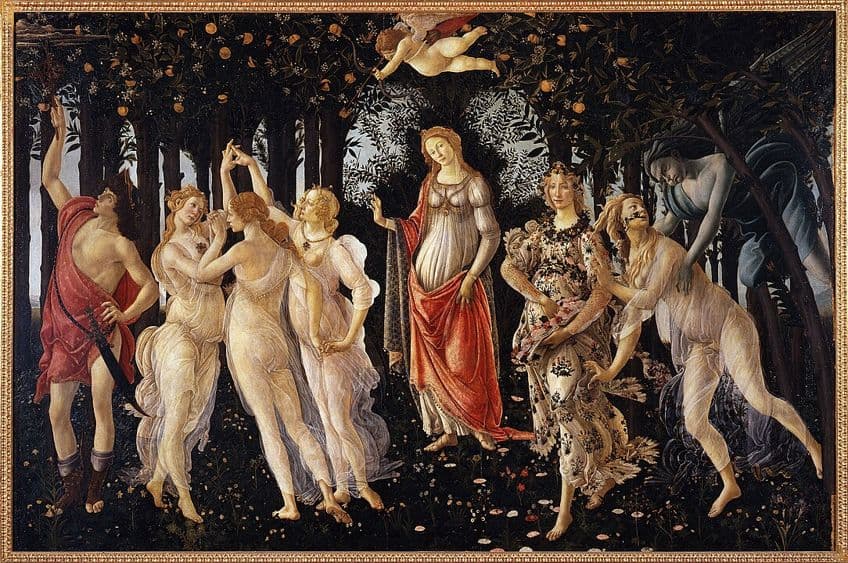
The Emergence of Humanism
One of the most fundamental principles and driving forces of Early Italian Renaissance art was the concept of humanism. This concept permeated beyond Italian art into all spheres of public life, such as religion, politics, science, literature, and philosophy. The philosophy of humanism embraced human creativity and intellect. This was a dramatic shift from the focus on the will of the divine and the minimization of human self-governance of the medieval era. Instead, the Renaissance era was exemplified by thinkers and creatives who were encouraged to explore new ideas, embrace scientific experimentation, and reach for new artistic and intellectual heights.
The Western world has ever since been influenced by the legacy of humanism.
A Return to Classicism
Italian Renaissance art did not eschew every aspect of the past, though, and this era embodied a rebirth in the interest in artworks from the Greco-Roman era, which many Italian Renaissance artists considered to be the last period of cultural excellence in human history. There was less stigma and fear surrounding the Classical era’s pagan roots and the general population became more accepting of its place in history, despite still being a very religious era. At this time, many classical Greco-Roman statues were being excavated, and Early Italian Renaissance artists studied these thoroughly. The history and mythology of the classical period became popular themes in Italian Renaissance painting, such as, for example, The School of Athens (1511) by Raphael.
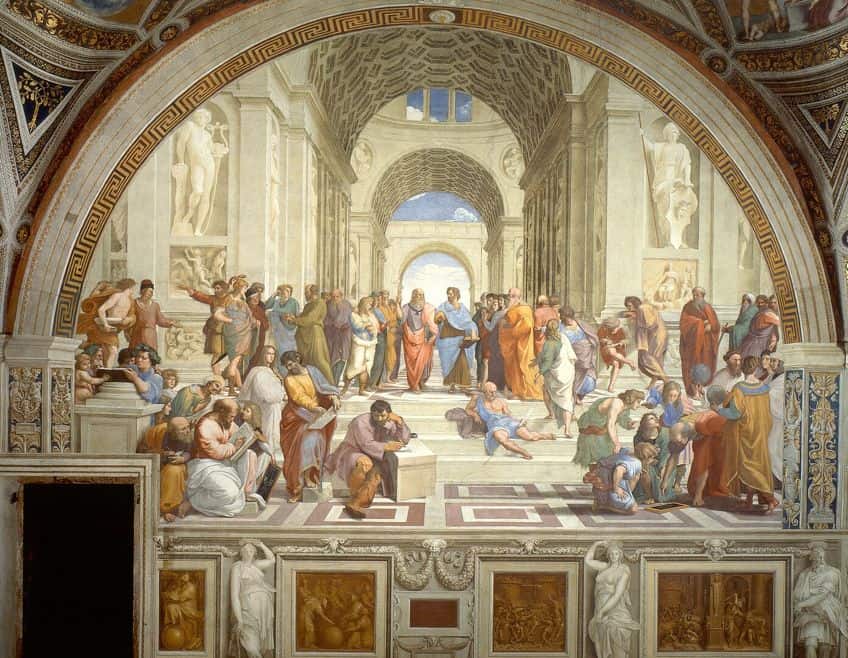 The School of Athens (1511) by Raphael; Raphael, Public domain, via Wikimedia Commons
The School of Athens (1511) by Raphael; Raphael, Public domain, via Wikimedia Commons
It was not just the subject matter of the Classical period that influenced Italian Renaissance art, though. They also incorporated the compositional arrangement techniques and poses of the Classical works of art. They felt that the artists of the Classical era had already figured out the perfect ratios and techniques for achieving outstanding artworks and examined them thoroughly so that they could emulate them. Many of the principles applied by the ancients were very complex and sophisticated, and understanding their nuances was something that only the most educated people could do.
Therefore, if an artist incorporated these Classical principles and symbols in their work, they were no longer seen as mere craftsmen, but also highly-respected intellectuals.
Reemergence of Realism
Italian artists aspired to portray the world around them with more realism as Italian Renaissance civilization became more scientifically inclined. Naturalistic art depicts its themes in a manner that corresponds to their appearance in reality. This aspiration to acquire a high degree of realism in one’s works would become one of the most fundamental Italian Renaissance characteristics in art. For the first time since antiquity, artwork in the Renaissance period featured anatomically correct human beings. Italian Renaissance painters mastered anatomy by drawing naked models. Others went so far as to discreetly examine cadavers in the hopes of improving their knowledge of human anatomy.
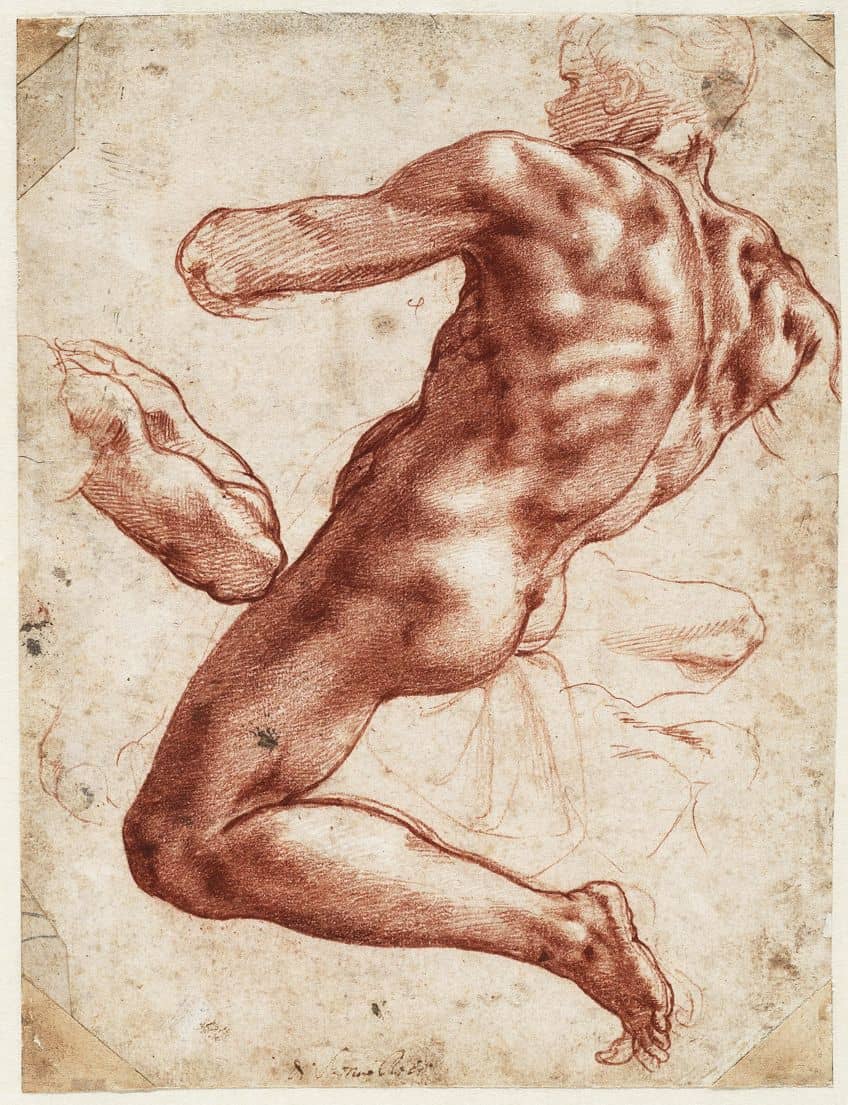 Study of an Ignudo (1511) by Michelangelo; Michelangelo, Public domain, via Wikimedia Commons
Study of an Ignudo (1511) by Michelangelo; Michelangelo, Public domain, via Wikimedia Commons
Italian Renaissance artists could represent individuals in intricate, dramatic, and artistically demanding positions using this understanding. They, like the ancients, wanted to depict the naked male form in all its muscular complexity. Italian Renaissance painters produced three-dimensional animal and human figures by representing them in highlights and shadows. This technique, known as chiaroscuro, imitates the way light falls over objects in real life. Sculptures’ stances also became less frontal and their modeling became more three-dimensional. But, it was not simply the shapes that became more lifelike. Italian artists of this period sought psychological as well as visual truth, producing brilliantly expressive effects that largely account for Italian Renaissance art’s long-term popularity.
The Development of Linear Perspective
The linear perspective concept developed by Filippo Brunelleschi enabled Italian artists to depict a lifelike impression of three-dimensional depth throughout their paintings. Linear perspective refers to the creation of a sequence of diagonal lines that all converge at a singular vanishing point on the horizon line. This concept mimics the way parallel lines appear to merge as they fade into the background in reality. The convergence of these lines produces a two-dimensional image that creates the impression of three-dimensional space.
It’s unknown whether ancient artists utilized a comparable technique, or if the linear perspective was essentially a Renaissance-era development.
The Phases of Italian Renaissance Art
We have just discussed a few of the most notable Italian Renaissance characteristics and concepts. Yet, these ideas did not all pop up simultaneously. There are several distinct phases of Italian Renaissance art in which these concepts and characteristics emerged.

Proto-Renaissance Art (13th – 14th Centuries)
The Proto-Renaissance phase from the late 13th to the early 14th centuries was characterized by considerable creative experimentation and development. This time period established the groundwork for subsequent Italian Renaissance art, which started in the 15th century. During the Proto-Renaissance, painters started experimenting with new forms and techniques, breaking away from the conventional Byzantine style of art.
Artists like Cimabue, Duccio di Buoninsegna, and Giotto di Bondone began to shift away from medieval-era flattened figures on golden backgrounds during the Proto-Renaissance, gradually adding dimension, depth, and expression to their works.
Giotto di Bondone was a prominent artist of the Proto-Renaissance era. His paintings emphasized authenticity and emotional expressiveness more than prior Byzantine-influenced artwork. He was noted for his skill in capturing his subjects’ psychological and emotional depth, as well as his ability to give his works a feeling of space and depth. Cimabue was recognized for his use of vibrant colors and expressive features, while Duccio di Buoninsegna merged Byzantine and Proto-Renaissance elements to produce a distinct and highly expressive aesthetic.

Early Italian Renaissance Art (14th – 15th Centuries)
This period saw a revival of interest in ancient learning and art, as well as an emphasis on humanism and independence. Artists continued to experiment with the Proto-Renaissance techniques of realism. They also started using methods like chiaroscuro or playing with shadows and light to produce dimension and contrast, and sfumato, which involves combining colors and tones to produce a soft, hazy ambiance.
Around this time, linear perspective methods were developed.
Masaccio was a pivotal figure in the Early Italian Renaissance, famed for his mastery of perspective and capacity for developing three-dimensional characters that seemed to inhabit real space. He was also recognized for his utilization of light and shadow to provide his figures with a feeling of solidity and depth. Filippo Brunelleschi, another famous artist of the Early Italian Renaissance, was also an engineer and architect. His work on the Florence Cathedral’s dome was a significant accomplishment of the era, demonstrating the period’s technological and creative advancements. Early Italian Renaissance art has an appealing, credible sense of naturalism, although it may lack the vitality of subsequent Renaissance masterpieces.

Italian High Renaissance Art (15th – 16th Centuries)
During this phase, Italian Renaissance artists refined the skills and concepts acquired during the previous Renaissance phases. They concentrated on producing pieces that were technically faultless as well as intellectually stimulating, with a focus on balance, harmony, and idealistic beauty. Leonardo da Vinci, one of the most prominent artists of the High Renaissance, was renowned for his technical skills, intellectual curiosity, and his capacity for creating works of immense emotional complexity and psychological depth.
Michelangelo, another famous artist of this phase, was recognized for his strong, muscular forms and his capacity for portraying the human form in motion.
Raphael was famed for his beautiful, balanced compositions, as well as his utilization of color and light to produce depth and mood within an artwork. The first half of the 16th century saw the development of artworks at the pinnacle of Renaissance ambitions. Beautifully modeled human forms in elaborate stances, dramatic and emotive compositions, thoroughly realistic renderings of space, and intellectually advanced subject matter characterize High Renaissance sculptures and paintings.
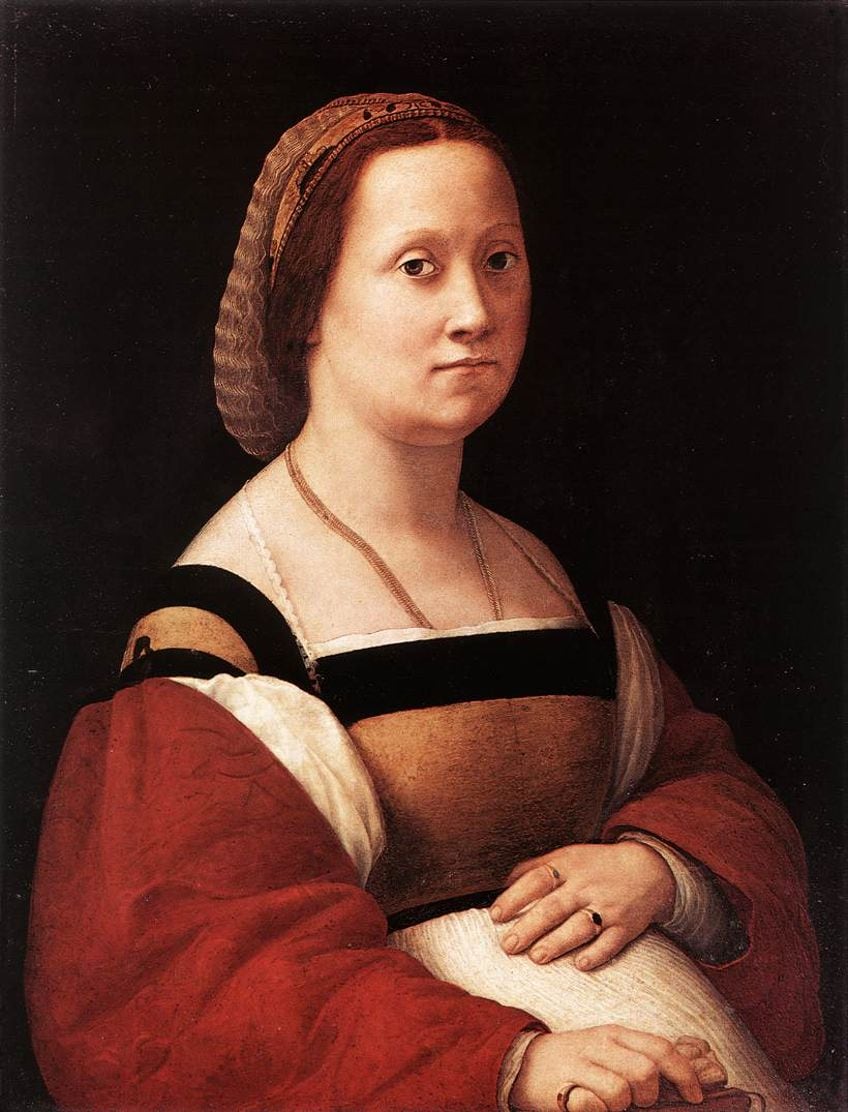
Mannerism (16th – 17th Centuries)
Mannerism was a style that emerged in Italy around the conclusion of the High Renaissance era in the latter part of the 16th century. It is usually regarded as a response to the High Renaissance’s idealistic harmony and beauty and is distinguished by a more unnatural and stylized approach to painting.
Nonetheless, the High Renaissance and Mannerism overlapped, and many Italian artists of the period were inspired by both.
Certain Italian artists, like Parmigianino, established a style that blended the romanticized beauty of the High Renaissance with Mannerism’s exaggerated stances and stretched figures. Some Italian Renaissance painters, like Jacopo Pontormo, abandoned the idealistic beauty of the High Renaissance in favor of a more exaggerated and emotive approach. His figures were usually stretched and distorted, with deformed faces expressing inner anguish and psychological complexities.
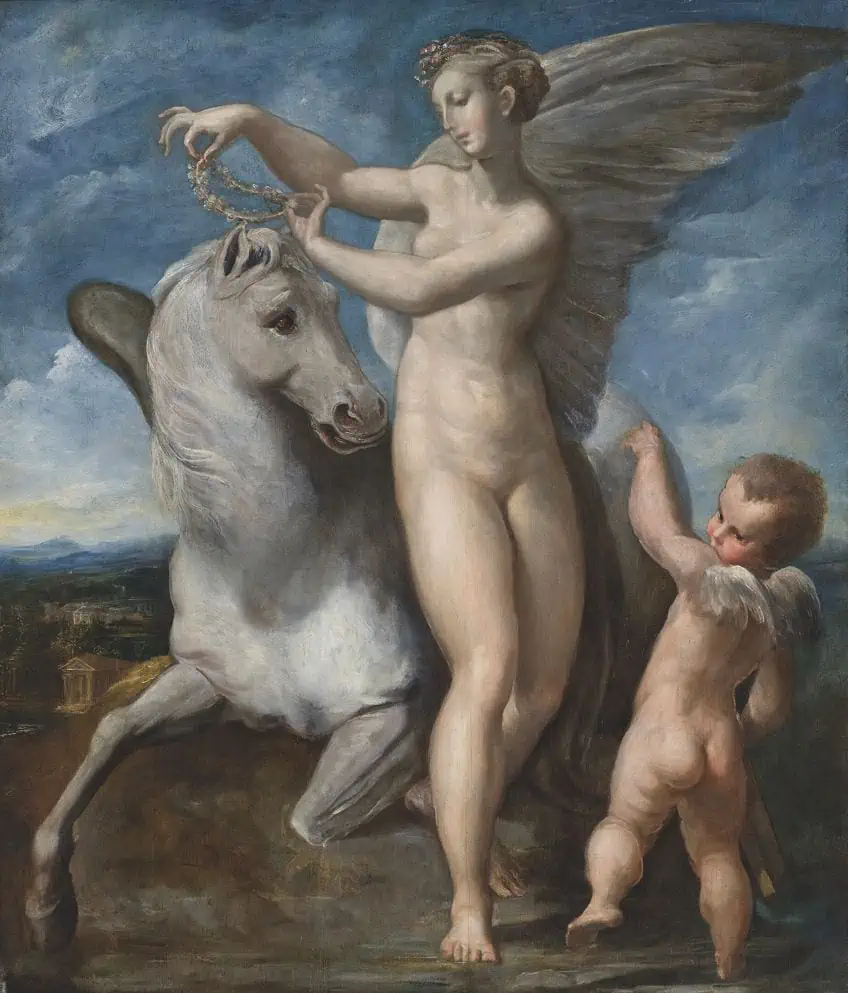
Important Italian Renaissance Artists
As we have mentioned in the section on the various phases of Italian Renaissance art, several significant artists emerged during this period, and each one brought something innovative and fresh to the table. Whether it was their application of perspective, or their accurate portrayals of the human physique, these Italian Renaissance artists all added to the artistic palette of techniques that are still utilized up to the present day.
Let us look at each of them in more depth.
Masaccio (1401 – 1428)
| Artist Name | Masaccio (born Tommaso di Ser Giovanni di Simone) |
| Date of Birth | 21 December 1401 |
| Date of Death | c. 1428 |
| Place of Birth | San Giovanni Valdarno, Italy |
Despite his brief life, Masaccio left an everlasting influence on the world of art. He was born in 1401, and he made a significant contribution to painting with his ability to portray lifelike characters and motions, in addition to his precise approach to perspective.
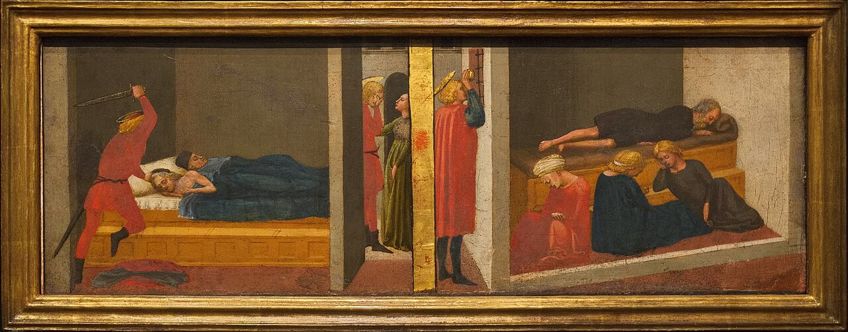
Many believe him to be the first great artist of the Italian Renaissance period and the originator of the modern age of painting. Regrettably, only four works that are certainly his remain today, but others have been ascribed to him in whole or in part. Masaccio’s family had no interest in the arts, which is rather remarkable given that the majority of the great artists who appeared throughout the Italian Renaissance period had some form of connection to the art world.
His work influenced generations of artists, including such luminaries as Michelangelo.
Sandro Botticelli (1445 – 1510)
| Artist Name | Sandro Botticelli |
| Date of Birth | c. 1445 |
| Date of Death | 17 May 1510 |
| Place of Birth | Florence, Italy |
Sandro Botticelli was an Italian artist born in Florence, Italy. He began his career as a goldsmith prior to becoming an apprentice to Florentine painter Filippo Lippi.
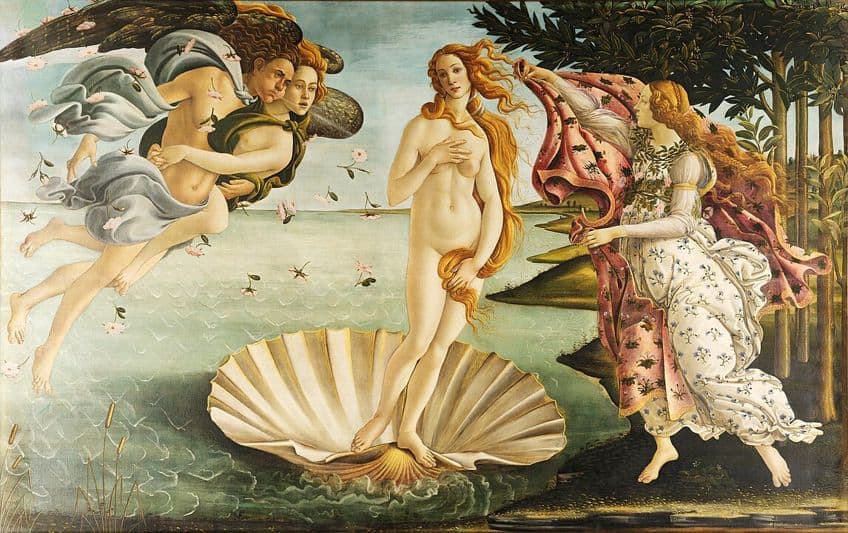
The Medici family commissioned Botticelli’s most famous works, which feature mythical themes. These Italian Renaissance paintings are famous for their use of brilliant colors and beautiful, flowing lines, which became hallmark Italian Renaissance characteristics. He was noted for his inventive compositions and meticulous attention to detail, which served to set a new benchmark for realism in Italian Renaissance painting.
Botticelli was an Early Renaissance painter whose exquisite renditions of the Madonna and Child, altarpieces, and life-size works were extremely popular during the Italian Renaissance period.
Domenico Ghirlandaio (1448 – 1494)
| Artist Name | Domenico Ghirlandaio (born Domenico di Tommaso Curradi di Doffo Bigordi) |
| Date of Birth | 2 June 1448 |
| Date of Death | 11 January 1494 |
| Place of Birth | Florence, Italy |
Domenico Ghirlandaio oversaw a vast and productive workshop in Florence that included his two brothers. Numerous apprentices, including Michelangelo, worked in his workshop.

The Early Renaissance artist became well-known for his elaborate narratives, which typically included prominent Florentine residents – in this way, he recorded contemporary Florentine life. Pope Sixtus IV called him to Rome to create a mural in the Sistine Chapel.
This became one of his most important commissions.
Leonardo da Vinci (1452 – 1519)
| Artist Name | Leonardo da Vinci (born Leonardo di ser Piero da Vinci) |
| Date of Birth | 15 April 1452 |
| Date of Death | 2 May 1519 |
| Place of Birth | Anchiano, Italy |
Leonardo da Vinci is often regarded as the personification of Renaissance humanism ideals. He was a virtuoso of many various types of art, but he is most known for his Italian Renaissance paintings.
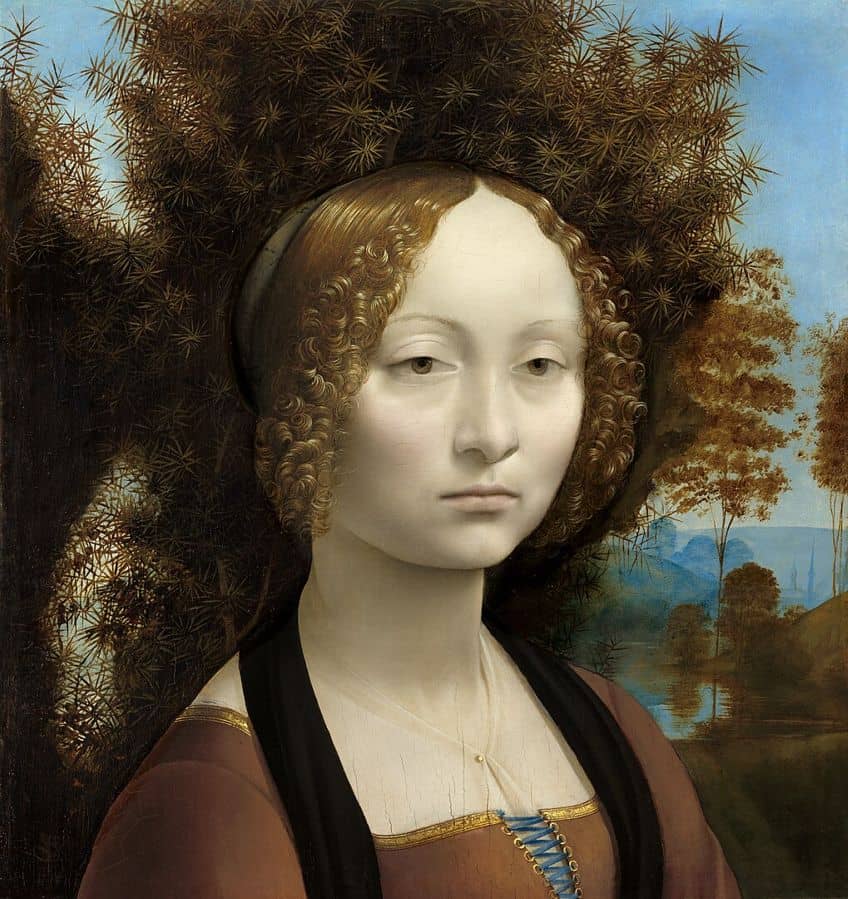
He was born out of wedlock and spent his younger years training in the workshop of Andrea del Verrocchio. Just around 15 of his paintings have survived the centuries. Leonardo da Vinci is acclaimed as an artist for his mastery of techniques such as chiaroscuro and sfumato, which allowed him to produce remarkably lifelike images. He also made major contributions to technology and science in addition to his creative achievements. Da Vinci was regarded not only by peers, but also historians as a quintessential Renaissance man.
His various interests and abilities served to characterize the era’s ethos, and he expanded the limits of what was imaginable in science, technology, and art.
Michelangelo (1475 – 1564)
| Artist Name | Michelangelo (born Michelangelo di Lodovico Buonarroti Simoni) |
| Date of Birth | 6 March 1475 |
| Date of Death | 18 February 1564 |
| Place of Birth | Caprese Michelangelo, Italy |
Michelangelo’s artwork had a significant impact on the Italian Renaissance and beyond. He was among the first Italian Renaissance artists to employ the human body as a basis for creative expression, and he established a highly personal style that highlighted his subjects’ psychological and emotional depth.
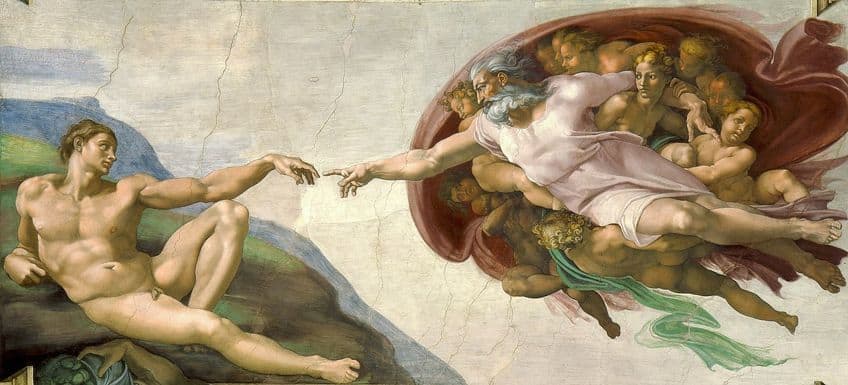
Michelangelo, as with his contemporary Leonardo da Vinci, was a virtuoso of numerous artistic disciplines, the most notable of which was painting. Many of the fundamental aspects of Renaissance painting, including the incorporation of perspective, the human body as a subject, and the significance of individuality and expression of emotion, were defined by his work. He created some of the most striking frescoes in Western art history in the Sistine Chapel at the Vatican.
The exquisite murals on the chapel ceiling took Michelangelo around four years to complete.
Raphael (1483 – 1520)
| Artist Name | Raphael (born Raffaello Sanzio da Urbino) |
| Date of Birth | 6 April 1483 |
| Date of Death | 6 April 1520 |
| Place of Birth | Urbino, Italy |
Raphael was a High Renaissance Italian painter noted for his beautiful, harmonic compositions and ability to represent the human figure in motion. Raphael was raised in Urbino by a royal painter, Giovanni Santi.

Raphael’s apprenticeship most probably started there, when he was introduced to masterpieces by notable artists such as Piero della Francesca and Andrea Mantegna. He was crucial in the development of art throughout the Italian Renaissance era, and his works served to create many of the stylistic traditions that would ultimately define the era. Raphael was most renowned for his utilization of color and light to convey a sense of depth and mood in his works.
His oeuvre served to develop the ideas of linear perspective and realism that would dominate Western art for generations to come.
Titian (1488 – 1576)
| Artist Name | Titian (born Tiziano Vecelli) |
| Date of Birth | c. 1488 |
| Date of Death | 27 August 1576 |
| Place of Birth | Pieve di Cadore, Italy |
Titian was the most famous Venetian painter of the 16th century. Titian is well known for his mastery of color and diversity – he was equally competent at producing landscapes, portraits, and mythical and religious subjects. Before striking out as an independent artist, he worked as a youth with notable Venetian painters such as Giovanni Bellini and Giorgione.
He quickly found himself painting for nobility all around Europe, notably King Philip II of Spain.

Titian created portraits of several prominent individuals throughout his career, including Holy Roman Emperor Charles V and Pope Paul III. Titian was particularly important in the formation of the Venetian painting school, which emphasized texture and color more than other schools during that era. His work contributed to the growth of painting in Italy and all through Europe, and he was much revered and emulated by other painters of the time.
We hope that you have now got a thorough understanding of Italian Renaissance art and the artists who helped establish and define the artistic principles of the era. As we have discovered, Italian art was shaped by various emerging factors during this period, such as the rise of humanism, realism, perspective, and a return to Classical forms and themes. The artistic advancements of this period have continued to be utilized and refined in the centuries that have passed, yet there are very few modern artists that can live up to the incredibly sophisticated and complex works that were produced during this pinnacle moment in the history of art.
Take a look at our Italian Renaissance webstory here!
Frequently Asked Questions
What Were the Most Notable Italian Renaissance Characteristics?
The Renaissance saw a rebirth of classical learning as well as a renewed focus on the individual, with a celebration of human dignity, value, and potential. Renaissance artists attempted to depict the world accurately, paying special attention to viewpoint, physiology, and how to employ light and shadow. It witnessed a transition away from the medieval emphasis on religious themes and toward secular subjects like history, mythology, and portraiture. Renaissance intellectuals stressed logic and empirical observation, which resulted in advancements in mathematics, science, and philosophy.
How Did Italian Renaissance Art Influence Art in the Long Term?
Long term, the Italian Renaissance influenced the creation of new styles and methods, as well as molding our view of the significance of art in human culture. Renaissance painters pioneered new painting methods, such as oil paint, and glazes, as well as a better grasp of biology and perspective. These techniques would eventually be explored and perfected, contributing to the emergence of new art styles and movements. Renaissance art highlighted the personal and human experience, with a new emphasis on the human body as well as our feelings and passions.
Jordan Anthony is a Cape Town-based film photographer, curator, and arts writer. She holds a Bachelor of Art in Fine Arts from the University of the Witwatersrand, Johannesburg, where she explored themes like healing, identity, dreams, and intuitive creation in her Contemporary art practice. Jordan has collaborated with various local art institutions, including the KZNSA Gallery in Durban, the Turbine Art Fair, and the Wits Art Museum. Her photography focuses on abstract color manipulations, portraiture, candid shots, and urban landscapes. She’s intrigued by philosophy, memory, and esotericism, drawing inspiration from Surrealism, Fluxus, and ancient civilizations, as well as childhood influences and found objects. Jordan is working for artfilemagazine since 2022 and writes blog posts about art history and photography.
Learn more about Jordan Anthony and about us.
Cite this Article
Jordan, Anthony, “Italian Renaissance Art – A Look at the Rebirth of Classicism.” artfilemagazine – Your Online Art Source. October 23, 2023. URL: https://artfilemagazine.com/italian-renaissance-art/
Anthony, J. (2023, 23 October). Italian Renaissance Art – A Look at the Rebirth of Classicism. artfilemagazine – Your Online Art Source. https://artfilemagazine.com/italian-renaissance-art/
Anthony, Jordan. “Italian Renaissance Art – A Look at the Rebirth of Classicism.” artfilemagazine – Your Online Art Source, October 23, 2023. https://artfilemagazine.com/italian-renaissance-art/.



